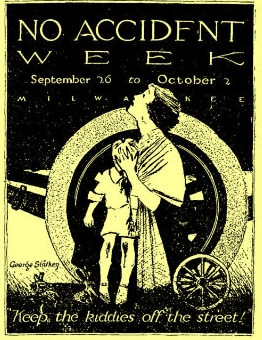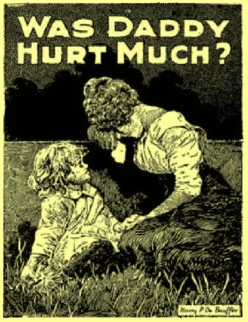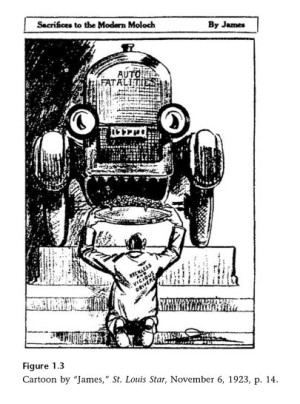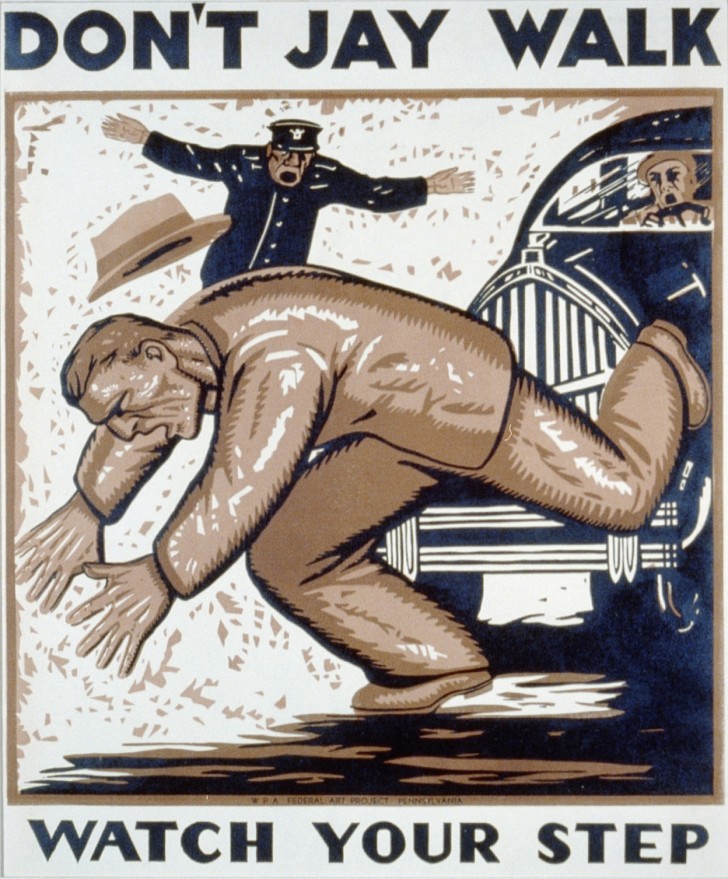On the streets of early 20th-century America, nothing moved faster than 10 miles per hour. Responsible parents would tell their children, “Go outside and play in the streets,” all day.
And then the automobile happened. And then automobiles began killing thousands of children, every year.

Much of the public viewed the car as a death machine. One newspaper cartoon even compared the car to Moloch, the god to whom the Ammonites supposedly sacrificed their children.
Pedestrian deaths were considered public tragedies. Cities held parades and built monuments in memory of children who had been struck and killed by cars. Mothers of children killed in the streets were given a special white star to honor their loss.

The main cause for these deaths was that the rules of the street were vastly different than how they are today. A street functioned like a city park, or a pedestrian mall, where you could move in any direction without really thinking about it. The only moving hazards were animals and other people.
Turn-of-the-century footage from San Francisco’s Market Street shows just how casually people strode into the street.
If a car hit someone, the car was to blame. From the New York Times, November 23, 1924:
The horrors of peace appear to be appalling than the horrors of war. The automobile looms up as a far more destructive piece of mechanism than the machine gun. The reckless motorist deals more death than artilleryman. The man in streets seems less safe than the man in the trench. The greatest single lethal factor is the automobile. It left shambles in its wake as it coursed through 1923.

Automotive interests banded together under the name Motordom. One of Motordom’s public relations gurus was a man named E. B. Lefferts, who put forth a radical idea: don’t blame cars, blame human recklessness. Lefferts and Motordom sought to exonerate the machine by placing the blame with individuals.
And it wasn’t just drivers who could be reckless—pedestrians could be reckless, too. Children could be reckless.
This subtle shift allowed for streets to be re-imagined as a place where cars belonged, and where people didn’t. Part of this re-imagining had to do with changing the way people thought of their relationship to the street. Motordom didn’t want people just strolling in.

So they coined a new term: “Jay Walking.”
In the early 20th century, “jay” was a derogatory term for someone from the countryside. Therefore, a “jaywalker” is someone who walks around the city like a jay, gawking at all the big buildings, and who is oblivious to traffic around him. The term was originally used to disparage those who got in the way of other pedestrians, but Motordom rebranded it as a legal term to mean someone who crossed the street at the wrong place or time.
Over time, Americans began to view their relationship to the automobile as a sort of love affair—which means that logic need not always apply. Groucho Marx even said so himself!





Comments (14)
Share
Fascinating podcast that gives an interesting perspective on something we consider so normal today.
I did find it interesting that you compare their campaign to a modern one calling people idiots, since here in Australia the TAC has had a campaign for years of “If you drink then drive, you’re a bloody idiot”. Then again they’ve always gone for very confronting and direct advertising campaigns – check out some of the TV spots on their wikipedia page (http://en.wikipedia.org/wiki/Transport_Accident_Commission).
After listening again tothis excellent episode I was reminded of this video, about a town in England trying to use design to regenerate the mixed users of a busy road junction:
http://www.youtube.com/watch?v=-vzDDMzq7d0
listeners and readers may be interested in Drachten:
“Recently, Drachten received international attention for a traffic experiment known as shared space, a concept pioneered by Hans Monderman. Almost all traffic lights and signs have been removed in the town’s centre in an effort to improve traffic safety, based on the theory that drivers pay more attention to their surroundings when they cannot rely on strict traffic rules. Previously the town’s centre had an average of 8 accidents per year. In the first two years after the system was introduced, yearly accidents were reduced to 1.”
from Wikipedia and also read more at
http://www.theguardian.com/politics/2002/jun/30/uk.transport
Bike&Chain… velorutionary literary art that analyzes the economic war waged by Automakers and Big Oil against the self propelled.
Ther very first recorded traffic accident in the United States occurred between a bicycle and a car in New York City at its first traffic signal. You can’t make such stuff up.
Enjoyed the podcat, but then was saddened to hear you’re unhappy with your WordPress website. I help people make their WordPress sites work better for them. Hit me up if you’d like to make yours better sometime.
Agatha Christie’s “Ten Little Indians” / “And Then There Were None” includes this as a minor part of a fantastic whodunit.
Great episode! I really think a complimentary that I would love for you to do a show on would be the General Motors Streetcar Conspiracy, which is directly responsible for the overall decline of public transit here in America, and the closure of the Los Angeles subway system: http://en.wikipedia.org/wiki/General_Motors_streetcar_conspiracy
Does anyone recognize background track playing in the first 30 seconds of the episode?
Anyone know the song playing in the first 30 seconds?
It is from the “Drive” soundtrack. I cant remember what song. Look it up and listen. All of the songs are really good. One of my favorites.
Isaiah’s right. It’s “Tick of the Click,” by Chromatics.
Great show. Just listened to it. I really appreciated how you wove in some of the history of the car but only just enough to give the main subject context without adding unnecessary bulk to the episode. Really engaging stuff once again.
As a pedestrian I have almost been hit by cars and buses while in the crosswalk with a green light. What is the term for the traffic that intrudes into the crosswalk? Jay drivers? Get off your cell phones idiots.